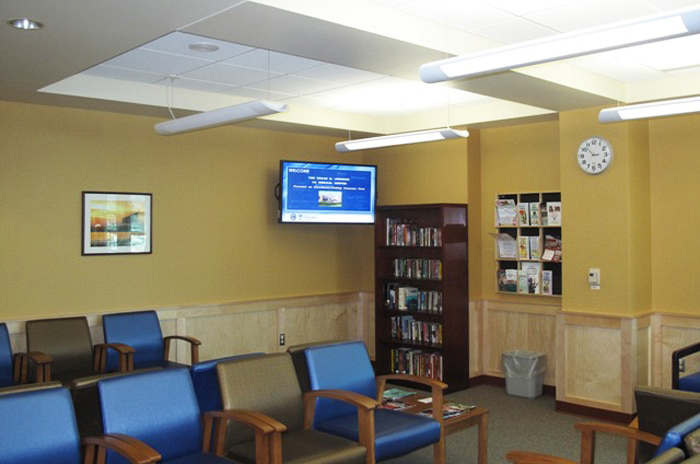Visix won a bid from the Great Lakes Acquisition Center to supply AxisTV digital signage software to the Oscar G. Johnson VA Medical Center in Iron Mountain, MI, as part of the U.S. Department of Veteran Affairs initiative to transform the VA into a streamlined, 21st century organization. “Monitors display content ranging from new and improved services and benefits to information about clinics and activities for veterans,” says Brad Nelson, Public Affairs Officer. “We needed to communicate patient education opportunities, and to promote disease prevention and health promotion.”
New processes and procedures are also an important part of the focus at Johnson. When the pharmacy switched to a new policy of having veterans renew prescriptions electronically, AxisTV helped promote the change. “The pharmacy now says that patients must use electronic means to renew meds, using the online 1-800 number rather than wait in lines; we put messages up a month before this got implemented, and it went really smoothly,” continues Nelson. “We’ve also had a push to get veterans to respond to their primary caregiver though secure electronic means.”
Many aspects of the system are going electronic and digital. “A lot of your health information and history can be now downloaded online, or you can send a secure message to your assigned doctor, RN or LPN,” says Nelson. “While there are other marketing efforts as well, digital signage has certainly helped.”
Nelson has 11 monitors up in waiting areas, in the canteen and near the director’s outer office pushing digital signage content of all kinds.

Andrea Nichols, Health Systems Specialist, Nursing, adds, “We also have a screen right in the main entrance, and it gives a good impression for patients when they enter the center.” Having been named a top performing hospital in the VA system in the annual Joint Commission report two years in a row, Nelson and Nichols understand the need to present a professional face to their audience.
“It isn’t all clinical – it’s pretty varied. But it all relates to our patients,” Nelson tells us. “It could be anything from healthy living messages, like don’t smoke or healthy eating, to group classes on sleeping well, or arts and crafts classes. A lot of our mental health service people call me up and ask for things to be put up on the monitors. We even put up messages about the parking lot getting repaved or about construction work on the building.”
Most of the content is created in AxisTV by importing images or PowerPoint, scheduling the content into a playlist, and publishing. “It’s just not hard to use,” says Nelson. “And the comments we’ve received have all been positive. We’ve seen increased participation in clinics and activities, and clinical and administrative staff routinely request information be put on the digital signage system, and have commented that the messages have had had the intended effect, i.e., more use of automated pharmacy orders, increased calls for clinics, and so on.”
Nelson prefers digital signage to the old way of doing things. “It’s a great way to get information in front of our patients – there’s a better chance they will see it than on a old-fashioned bulletin board – and more efficient than posting hard copy flyers or posters throughout the medical center.”
He also notes that the demographics are shifting, with younger veterans who have grown up more accustomed to receiving information in a digital, multimedia format. “We’re getting a younger and younger crowd,” says Nelson. “Many of the veterans are still in their 40s or older, but we also have a growing number in their 20s and 30s.”
AxisTV is also flexible and easily scalable for future growth. “The nice thing is that, if we grow and gain additional waiting rooms, we can expand this system with no problems,” says Nichols. “It makes no sense at all to use a different system.”